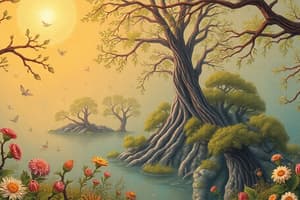Podcast
Questions and Answers
What is the primary role of decomposers in an ecosystem?
What is the primary role of decomposers in an ecosystem?
- To produce energy through photosynthesis
- To consume herbivores
- To create new food chains
- To recycle chemical substances back into the environment (correct)
Which group of organisms is primarily responsible for converting radiant energy from the sun into chemical energy?
Which group of organisms is primarily responsible for converting radiant energy from the sun into chemical energy?
- Decomposers
- Carnivores
- Photosynthetic organisms (correct)
- Herbivores
What accurately reflects the flow of energy in a food web?
What accurately reflects the flow of energy in a food web?
- Energy flow occurs in both directions between all trophic levels
- Energy flows from producers to herbivores, then to carnivores and decomposers (correct)
- Energy is stored indefinitely within organisms
- Energy moves in a circular pattern among consumers only
Which of the following accurately describes omnivores?
Which of the following accurately describes omnivores?
What happens to energy as it moves up the trophic levels in an ecosystem?
What happens to energy as it moves up the trophic levels in an ecosystem?
Which of the following best describes the role of predators in an ecosystem?
Which of the following best describes the role of predators in an ecosystem?
How does a food chain differ from a food web?
How does a food chain differ from a food web?
Which of the following groups of organisms does NOT consume other living organisms?
Which of the following groups of organisms does NOT consume other living organisms?
What is the carrying capacity of an environment dependent on?
What is the carrying capacity of an environment dependent on?
Which of the following best describes parasitism?
Which of the following best describes parasitism?
Which of the following statements about autotrophs is true?
Which of the following statements about autotrophs is true?
Which type of heterotroph specifically feeds on dead organic matter?
Which type of heterotroph specifically feeds on dead organic matter?
What is required for an ecosystem to be self-sustaining?
What is required for an ecosystem to be self-sustaining?
What is ecology primarily concerned with?
What is ecology primarily concerned with?
What do food chains and food webs illustrate?
What do food chains and food webs illustrate?
Which level of ecological organization follows molecules?
Which level of ecological organization follows molecules?
Which process primarily aids in the recycling of nutrients in an ecosystem?
Which process primarily aids in the recycling of nutrients in an ecosystem?
What is an essential requirement for a self-sustaining ecosystem?
What is an essential requirement for a self-sustaining ecosystem?
The inability of heterotrophs to synthesize their own food indicates that they are:
The inability of heterotrophs to synthesize their own food indicates that they are:
Which of the following components is NOT part of the biosphere?
Which of the following components is NOT part of the biosphere?
Which of the following describes an ecosystem?
Which of the following describes an ecosystem?
What is the smallest functional unit of life?
What is the smallest functional unit of life?
The cycling of materials between organisms and their environment is important because it:
The cycling of materials between organisms and their environment is important because it:
Which of the following is NOT considered an abiotic factor in an ecosystem?
Which of the following is NOT considered an abiotic factor in an ecosystem?
What percentage of energy from one trophic level is typically available to the next level?
What percentage of energy from one trophic level is typically available to the next level?
What role do decomposers play in the ecosystem?
What role do decomposers play in the ecosystem?
Why is energy loss significant at each trophic level in a food web?
Why is energy loss significant at each trophic level in a food web?
What is the primary source of energy for an ecosystem?
What is the primary source of energy for an ecosystem?
Which statement about climax communities is true?
Which statement about climax communities is true?
Which of the following best describes primary consumers in a food web?
Which of the following best describes primary consumers in a food web?
What ultimately happens to energy as it moves through an ecosystem?
What ultimately happens to energy as it moves through an ecosystem?
What is indicated by the energy levels in a food web?
What is indicated by the energy levels in a food web?
What occurs when two different species compete for the same food source?
What occurs when two different species compete for the same food source?
Which term describes an organism’s role in relation to food within the community?
Which term describes an organism’s role in relation to food within the community?
What must occur in a self-sustaining ecosystem regarding materials?
What must occur in a self-sustaining ecosystem regarding materials?
What percentage of air is composed of nitrogen?
What percentage of air is composed of nitrogen?
Which process is NOT part of the water cycle?
Which process is NOT part of the water cycle?
What is the primary purpose of a habitat?
What is the primary purpose of a habitat?
How much of the Earth’s surface is composed of oceans?
How much of the Earth’s surface is composed of oceans?
Which cycle involves respiration and excretion processes?
Which cycle involves respiration and excretion processes?
Flashcards are hidden until you start studying
Study Notes
Ecology Overview
- Biosphere: The portion of Earth that encompasses all ecosystems, comprising complex interrelated systems.
- Ecology Definition: The study of interactions between living (biotic) and non-living (abiotic) components in environments.
Ecological Levels
- Molecules: Smallest units of most chemical compounds; groups of atoms.
- Cells: The smallest functional units of life.
- Groups of Cells: Composed of tissues, organs, and organ systems.
Carrying Capacity
- Definition: Maximum number of organisms an area can support based on available resources and ecosystem's recycling abilities.
Nutritional Relationships
- Autotrophs: Organisms (plants) that synthesize their own food using inorganic compounds and energy (e.g., sunlight).
- Heterotrophs: Organisms (animals) that depend on other organisms for sustenance, cannot produce their own food.
- Types of Heterotrophs:
- Saprophytes: Feed on decaying organic matter (bacteria, fungi).
- Herbivores: Consume plant matter.
- Carnivores: Feed on other animals.
- Predators: Hunt and eat prey.
- Scavengers: Feed on dead animals.
- Omnivores: Eat both plant and animal matter.
- Types of Heterotrophs:
Symbiotic Relationships
- Symbiosis: Mutual, beneficial relationships between different species.
Energy Flow
- Energy Dynamics: Energy flows unidirectionally through ecosystems, originating from the sun and moving through producers to consumers and decomposers.
- Food Chain and Web: Represents energy transfer through various trophic levels, illustrating complex interactions and feeding relationships.
- Energy Decrease: Energy diminishes with each trophic level, typically represented as 100% → 75% → 50% → 25% → 0%.
Food Web Interactions
- Producers: Primary source of energy in ecosystems, generating organic compounds from sunlight.
- Primary Consumers: Herbivores that feed on producers.
- Secondary Consumers: Carnivores that prey on primary consumers.
- Decomposers: Breakdown organic waste and dead organisms, recycling nutrients back into the environment.
Biomass and Climax Community
- Biomass: Total mass of living organisms in a particular area, decreases with each successive trophic level.
- Climax Community: A stable and self-perpetuating ecosystem dominated by a specific plant species until a significant disturbance occurs (e.g., fires, floods).
Niche and Habitat
- Niche: The role of an organism within its community, especially concerning food and interaction with other species.
- Habitat: The specific environment in which a plant or animal resides, providing necessary resources.
Material Cycles
- Recycling: Ecosystems must cycle materials among living organisms and their abiotic environment. The same materials can be reused.
Major Biogeochemical Cycles
- Carbon Cycle: Involves the movement of carbon through the environment, affecting various life forms and processes.
- Nitrogen Cycle: Essential for building proteins and nucleic acids; involves different forms of nitrogen utilized by living organisms.
- Phosphorus Cycle: Critical for energy transfer and genetic material.
- Water Cycle: Encompasses processes like evaporation, condensation, and transpiration, essential for ecosystem function.
Composition of Air
- Nitrogen: 78%
- Oxygen: 20.9%
- Other Gases: Includes Argon (>0.9%) and Carbon Dioxide (0.03%).
Biomes
- Oceans: Cover about 70% of Earth's surface and support diverse ecosystems.
Studying That Suits You
Use AI to generate personalized quizzes and flashcards to suit your learning preferences.




